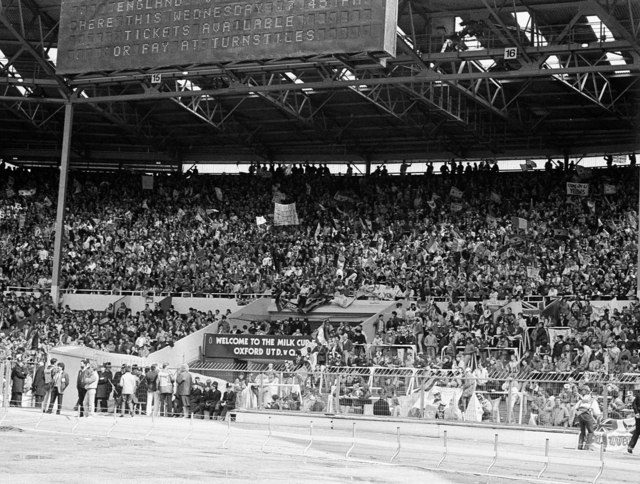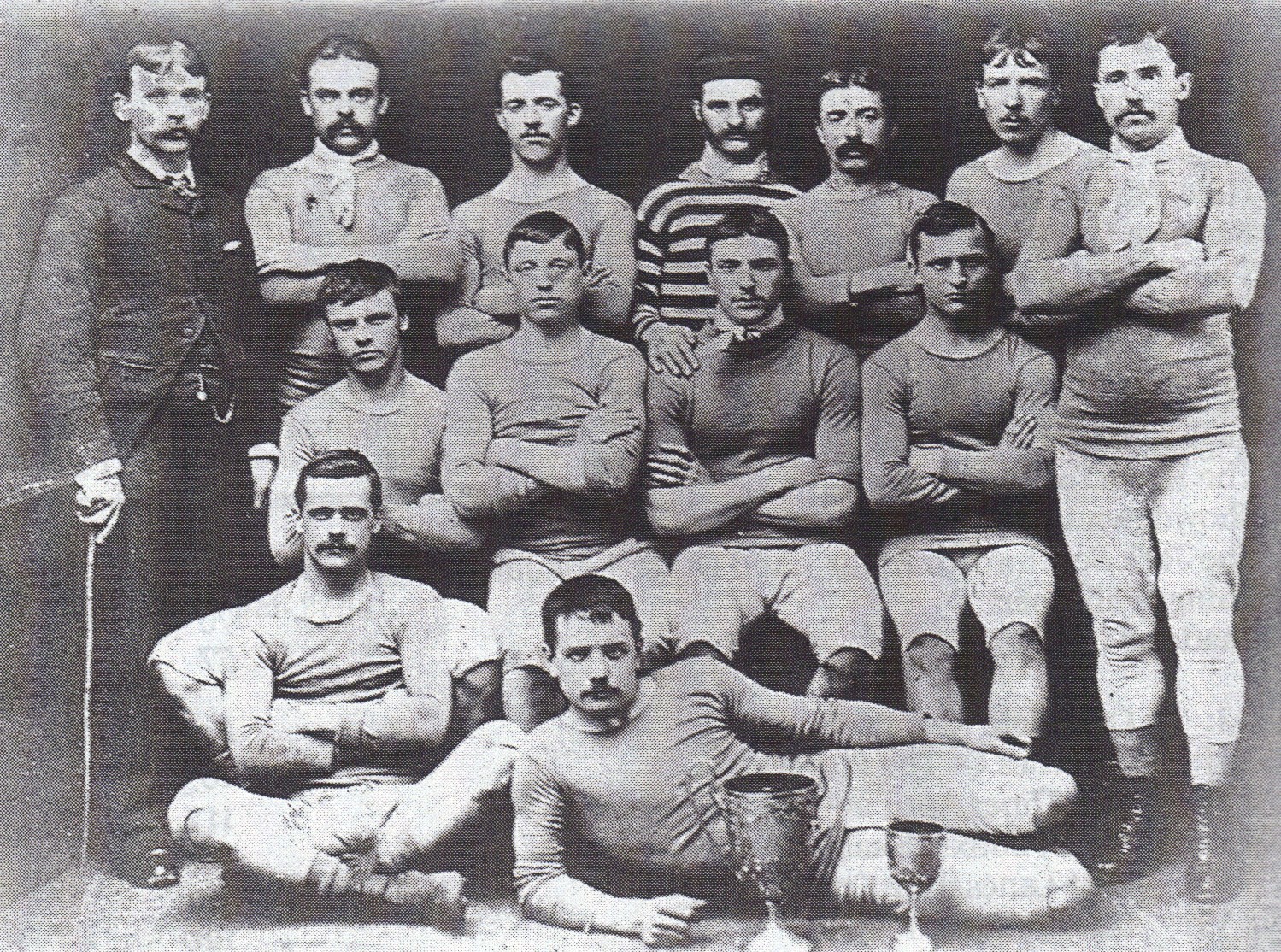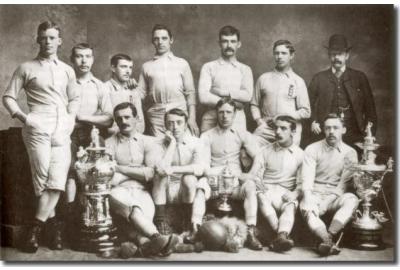Football has long been enshrined as one of the world’s most popular pastimes, thanks in large part to the sheer universal appeal of the sport.
With ball games a common passion of cultures around the world, it’s little wonder that soccer has been able to capture the imagination of such a large global audience, with an estimated 250 million players across more than 200 nations.
However, the enduring popularity of football doesn’t mean it hasn’t had to change and evolve over the years.
In fact, it’s perhaps because of that phenomenal popularity that association football has undergone some major shifts in the way the sport is played, viewed and presented - some of which have been seismic enough that a fan from the early days of the sport probably wouldn’t recognise the game as it exists today.
With this in mind, TOFFS has put together an eye-opening account of the most prominent ways in which football has evolved since its earliest days in the 1800s, in order to better understand the impact these changes have had on creating the sport we all know and love.
Changing rules

No sport comes into the world fully formed, without any revisions or updates to the rules over time - but even so, many modern football fans might be surprised to learn just how much the beautiful game has changed since the original laws of the game were codified during a historic meeting at the Freemasons’ Tavern in Blackheath.
Here’s the complete list of all 13 original rules:
- The maximum length of the ground shall be 200 yards, the maximum breadth shall be 100 yards, the length and breadth shall be marked off with flags; and the goal shall be defined by two upright posts, eight yards apart, without any tape or bar across them.
- A toss for goals shall take place, and the game shall be commenced by a place kick from the centre of the ground by the side losing the toss for goals; the other side shall not approach within 10 yards of the ball until it is kicked off.
- After a goal is won, the losing side shall be entitled to kick off, and the two sides shall change goals after each goal is won.
- A goal shall be won when the ball passes between the goal-posts or over the space between the goal-posts (at whatever height), not being thrown, knocked on, or carried.
- When the ball is in touch, the first player who touches it shall throw it from the point on the boundary line where it left the ground in a direction at right angles with the boundary line, and the ball shall not be in play until it has touched the ground.
- When a player has kicked the ball, any one of the same side who is nearer to the opponent's goal line is out of play and may not touch the ball himself, nor in any way whatever prevent any other player from doing so, until he is in play; but no player is out of play when the ball is kicked off from behind the goal line.
- In case the ball goes behind the goal line, if a player on the side to whom the goal belongs first touches the ball, one of his side shall he entitled to a free kick from the goal line at the point opposite the place where the ball shall be touched. If a player of the opposite side first touches the ball, one of his side shall be entitled to a free kick at the goal only from a point 15 yards outside the goal line, opposite the place where the ball is touched, the opposing side standing within their goal line until he has had his kick.
- If a player makes a fair catch, he shall be entitled to a free kick, providing he claims it by making a mark with his heel at once; and in order to take such a kick he may go back as far as he pleases, and no player on the opposite side shall advance beyond his mark until he has kicked.
- No player shall run with the ball.
- Neither tripping nor hacking shall be allowed, and no player shall use his hands to hold or push his adversary.
- A player shall not be allowed to throw the ball or pass it to another with his hands.
- No player shall be allowed to take the ball from the ground with his hands under any pretext whatever while it is in play.
- No player shall be allowed to wear projecting nails, iron plates, or gutta percha on the soles or heels of his boots.
As you can see, many of the basic fundamentals of the game that are still used today were set down in stone on that day in 1863… while some of the other rules have fallen by the wayside.
As interesting as it would be to see modern sides having to re-adapt to the rule that players can gain a free kick by catching the ball with their hands, it’s hard to imagine that particular law making a comeback!
Perhaps just as striking as those unusual inclusions are the omissions: you’ll notice, for example, that goals did not include crossbars in these original rules, nor were there any provisions for penalties, referees, sendings-off or even goalkeepers.
Those additions came later on, as you can see from this timeline of subsequent important amendments:
1866 - The offside rule is modernised from its original form (which made it illegal for any attacking player to be positioned ahead of the ball) to a three-player rule, whereby attackers would only be offside if positioned in front of the third-from-last defender. This was relaxed further to a two-player rule in 1925
1870 - Handling the ball is banned in all circumstances, meaning players are no longer allowed to catch the ball from midair
1871 - The goalkeeper position is introduced, though goalies are initially allowed only to handle the ball “for the defence of their goal”. They would not be permitted to handle the ball at any time until 1901
1875 - The option of a crossbar was introduced as an alternative to tape between the goalposts. Crossbars were subsequently made mandatory with the unification of football rules across England, Scotland, Wales and Ireland in 1882
1881 - Referees are formally introduced to the game, replacing the previous system of rules being enforced by team captains and informal umpires. At the same time, it became possible for players to be cautioned and sent off
1891 - Penalty kicks are created, originally under the name “the kick of death”. Pitch markings were also introduced for the goal area, penalty area, centre spot and centre circle, along with the debut of linesmen
1897 - The halfway line is introduced, with the maximum length of the ground shrinking from 200 yards to 130 yards
1902 - The size of the goal area and penalty area are set at six yards and 18 yards from the goal posts, respectively, with a designated penalty spot also introduced
1937 – The "D" is added to the edge of the penalty area, to ensure that players do not encroach when a penalty is being taken
1970 - Yellow and red cards are brought in for players being cautioned and sent off
1990 - The offside rule is revised to allow attackers to remain onside even when they are level with the second-from-last opponent
1992 - The backpass rule is invented, stopping goalkeepers from picking the ball up when it has been deliberately passed to them by a teammate
2012 - Goal-line technology is now permitted for use in the game, to check whether a ball has crossed the line or not
2018 - Video assistant referees are brought into the game for the first time
Naturally, football fans will have their own opinions on which of these rule changes has had the greatest positive or negative impact on the game - especially when it comes to VAR! - but there’s no doubt that each of these developments has played a major role in turning football from a chaotic, rugby-like sport into the slick, passing-based and ultra-professional game we enjoy so much today.
Transfer fees

You might think of the business of football clubs buying and selling top players for massive fees as a relatively recent development for the sport, but a glance back over the history of the game shows that this has been happening since the 19th century - even if the definition of a “record fee” has changed somewhat since then!
The concept of player transfers originated in 1885, when the Football Association established the professional game and a system of player registrations in England for the first time.
This required players to register on the playing staff of a particular club, which they would not be allowed to leave without permission from their club - a rule that would remain more or less unchanged until the landmark legal ruling in favour of Jean-Marc Bosman in 1992, which made it possible for players to leave their club for free once their contract had expired.
Naturally, the introduction of player registration quickly created a market for clubs to start trying to outbid each other for the cream of the available playing talent, with a rapid escalation in transfer records that continues today:
1893 - Willie Groves moves from West Bromwich Albion to Aston Villa, setting a transfer record of £100 less than a decade after the game went professional
1905 - Alf Common secures the first four-figure transfer, moving from Sunderland to Middlesbrough for £1,000 only a year after a prior record move of £520 from Sheffield United
1928 - David Jack’s move from Bolton Wanderers to Arsenal secures the first five-figure transfer fee at £10,890. This was also Jack’s second world record-breaking transfer, a distinction he shares with Alf Common, Diego Maradona and the Brazilian Ronaldo
1932 - Argentinean star Bernabé Ferreyra moves from Tigre to River Plate for the equivalent of £23,000, marking the first time the transfer record was broken by a sale outside of England. This record would last for 17 years, the longest spell of its kind
1961 - Spanish legend Luis Suárez moves from Barcelona to Internazionale for £152,000, the first ever transfer to break the six-figure mark
1975 - Giuseppe Savoldi becomes the world’s first million-pound player, transferring from Bologna to Napoli for £1.2 million
1982/1984 - Diego Maradona shatters the previous transfer record of £1.75 million twice in three years, moving from Boca Juniors to Barcelona for £3 million in 1982, then on to Napoli for £5 million in 1984
1992 - Jean-Pierre Papin breaks the £10 million mark with his move from Marseille to AC Milan
1996 - Alan Shearer is sold by Blackburn Rovers to his boyhood club Newcastle United for £15 million, the first English world record transfer since 1951
1997 - Brazil’s Ronaldo reclaims the record from Shearer, following his then-record £13.2 million transfer from PSV Eindhoven in 1996 with another landmark switch to Internazionale for £19.5 million
2000-2013 - Real Madrid break the world transfer record five times with the signings of Luís Figo from rivals Barcelona in 2000 for £37 million, Zinedine Zidane from Juventus for £46.6 million in 2001, the double purchase of Kaká from AC Milan for £56 million and Cristiano Ronaldo for £80 million from Manchester United in 2009, and finally Gareth Bale from Tottenham Hotspur for £86 million in 2013
2017 - Neymar moves from Barcelona to Paris Saint-Germain for £198 million, more than doubling the previous £89 million world record set by Paul Pogba’s return from Juventus to Manchester United just a year earlier
As more and more money flows into the game, it’s inevitable that Neymar’s record will one day be broken again - a far cry from the days when £100 would secure you a record-breaking striker!
Ticket prices
Of course, all that money being spent on the Neymars and Pogbas of this world isn’t just being generated from thin air.
Although sponsorship and commercial deals have helped football’s top clubs level up to ever greater levels of wealth, there’s no denying that much of that cash is coming out of matchday punters’ pockets in ever-greater amounts.
A 2016 analysis of historical ticket price trends from sports historians Martin Johnes and Matthew Taylor revealed that gradual price escalation for top-tier football has been a reality since the birth of the professional game.
From its outset, the Football League had a rule in place imposing a minimum admission charge for matches to prevent price competition between clubs, which crept up gradually from one shilling (s) in the early days to 1s and 3 pennies (d) by 1946, 1s 9d in 1950, 2s in 1955 and 2s 6d in 1960. Costs would also be higher for particularly glamorous games, such as major cup ties.
During this early period for the game, fans’ perceptions of value for money in football tended to rise and fall depending on the current state of the economy and inflation rates, the availability of other entertainment sources, and the prestige of the sport itself at the time.
Concerns about poorer fans being “priced out” of matchday attendance have been a long-time point of contention, but they gained even more traction with the advent of the Premier League in 1992, which transformed the top-flight game into a much more glamorous and expensive product.
As such, from 1989 to 1999 top-flight ticket prices rose by 312% (compared to a nationwide inflation rate of only 54.8% during this period), with a 2011 report suggesting that some grounds had seen a 1,000% rise in matchday costs over two decades.
Those who were able to pay these prices have been treated to some amazing football during this time, with Premier League clubs increasingly able to attract the world’s very best players and managers thanks to their newfound wealth, but worries about the accessibility of the game have certainly grown.
Nowadays, the Premier League conducts comprehensive research into ticket price trends each year, in order to prevent out-of-control price rises.
According to its most recent figures for the 2019/20 season, the average price paid for a Premier League ticket is now £32, compared with £31 in 2018/19 and £32 in 2017/18.
53% continue to pay £30 or less per match, with 21% paying £20 or less - which suggests that although the beautiful game remains costly, clubs are still making an effort to ensure it remains affordable for everyday matchgoers.
Attendances and viewership

There’s no doubt that football has gotten more and more popular with each passing year, but that hasn’t always been accompanied by rising matchday attendances - at least not in the way you might think..
To illustrate this point, here’s a ranking of the top ten record attendances for club games in England since records began:
Tottenham Hotspur vs Bayer Leverkusen - UEFA Champions League, Wembley Stadium - Attendance of 85,512 in November 2016
Manchester City vs Stoke City - FA Cup, Maine Road - Attendance of 84,569 in March 1934
Chelsea vs Arsenal - First Division, Stamford Bridge - Attendance of 82,905 in October 1935
Manchester United vs Arsenal - First Division, Maine Road - Attendance of 81,962 in January 1948
Everton vs Liverpool - First Division, Goodison Park - Attendance of 78,299 in September 1948
Aston Villa vs Derby County - FA Cup, Villa Park - Attendance of 76,588 in March 1946
Sunderland vs Derby County - FA Cup, Roker Park - Attendance of 75,118 in March 1933
Charlton Athletic vs Aston Villa - FA Cup, The Valley - Attendance of 75,031 in February 1938
Arsenal vs RC Lens - UEFA Champions League, Wembley - Attendance of 73,707 in November 1998
Sheffield Wednesday vs Manchester City - FA Cup, Hillsborough - Attendance of 72,841 in February 1934
As you can see, with the exception of a couple of Champions League games hosted at Wembley, the vast majority of England’s biggest football crowds were seen during the 1930s and 40s - reflecting the fact that since that time, stadium designs have shifted away from standing terraces towards all-seater stadia, which has significantly reduced their maximum capacity.
Most fans will appreciate the safety reasons that motivated this change, particularly in the aftermath of the 1989 Hillsborough stadium disaster.
However, it means that modern club matches are unlikely to ever again reach the heights seen in the earlier parts of the 20th century - never mind the 100,000+ crowds recorded throughout history at stadia like Hampden Park in Scotland, or the official world record of just under 200,000 crowding into Rio de Janeiro’s Maracana stadium to watch Brazil play Uruguay in the final match of the 1950 World Cup.
However, the advent of TV broadcasting has created a whole new way for fans to spectate the game, and ensured that the sport now accounts for many of the most-watched broadcasts in world history.
With more than three billion people tuning into each of the last six World Cup tournaments, it’s hard to claim that the smaller stadium attendance figures are evidence of any decline in football’s popularity!
Kits

Now here’s a topic we at TOFFS know a lot about! As we all know, football kits today have become just as iconic as the players who wear them - but there was once a time when the sport’s whole approach to kit design was very different.
Believe it or not, the oldest record of purpose-designed kit specifically for playing football dates all the way back to the Great Wardrobe of King Henry VIII in 1526 - which included a pair of football boots!
However, it would be a long time before the concept of a formal football kit would come into being, with most games played up to the mid-19th century using whatever clothes were available, with coloured caps and sashes distinguishing between the two sides.
The first standardised uniform kits didn’t start to emerge until the 1870s, although modern fans would be hard-pressed to recognise them as football kits - not only did this attire often include caps, cowls, full trousers, belts and braces, but the designs of these kits were often garishly patterned and prone to regular changes, with some teams cycling through multiple kit designs in the same year.
From there, we can piece together a rough timeline of the evolution of the football kit into what we all recognise today:
1874 - Nottingham Forest player Sam Weller Widdowson pioneers the use of shinpads, cutting down a pair of cricket pads to wear outside his stockings during the match. These evolved into smaller shinpads worn inside the stockings by the turn of the century
1892 - The Football League introduces a rule requiring teams to have a second kit (initially plain white tops) to be worn when both sides used a similar kit design. This replaced an 1891 ruling that no two clubs could use the same kit colours
1904 - The rule dictating that players’ knickerbockers must cover their knees is dropped, leading to the development of football shorts
1909 - Goalkeepers are required for the first time to wear a different colour kit from their teammates, helping referees to distinguish them in crowds
1933 - In the FA Cup final between Manchester City and Everton, the players’ shirts were numbered for the first time, with Everton’s players numbered 1 to 11 and City's running from 12 to 22
1939 - Numbers on the back of players' shirts becomes mandatory
1950s - Overseas clubs experiment with more lightweight kits, using synthetic fibres and V-necks instead of collars. This “continental” style soon caught on in the UK as well
1954 - Adidas introduces the first boots to be cut below the ankle rather than using a high-topped design. Around the same time, the manufacturer also pioneered boots that used screw-in studs, which could be changed according to conditions
1973 - Germany’s Eintracht Braunschweig becomes the first side to agree a shirt sponsorship deal, with local alcohol producer Jägermeister displaying its logo on the front of their shirts. The practice is legalised in England in 1977 and soon catches on, with Liverpool being the first Football League side to do so in 1979
1975 - Leeds United become the first club to design and sell replica kits to fans, a highly commercial idea that soon becomes extremely popular
1980s - Traditional cotton shirts are largely replaced by artificial polyester fabrics, with kit designs becoming more intricate and complex, incorporating elements such as shadow prints and pinstripes
1991 - Tottenham Hotspur strike back against a growing trend towards increasingly short shorts, reverting to old-fashioned baggy shorts during their FA Cup final victory, and helping to re-standardise this design approach in the UK
1992 - The dawn of the Premier League coincides with the introduction of player names printed on the back of kits
1990s - As the replica kit market grows, shirt designs - especially for away shirts and third kits - become increasingly gaudy and attention-grabbing, a trend that will be reversed (to some degree!) in the decades that followed
Today, football shirt design is seen as a precise art, with clubs paying hundreds of millions to manufacturers to design and sell the most advanced and stylish shirts to punters around the world.
It’s hard to argue that the kits of today aren’t more sophisticated than the simple jerseys of decades past - but for old-school fans, there’ll always be something about those retro football shirts from the good old days that simply can’t be beaten, and that's what we're all about celebrating here at TOFFS!











